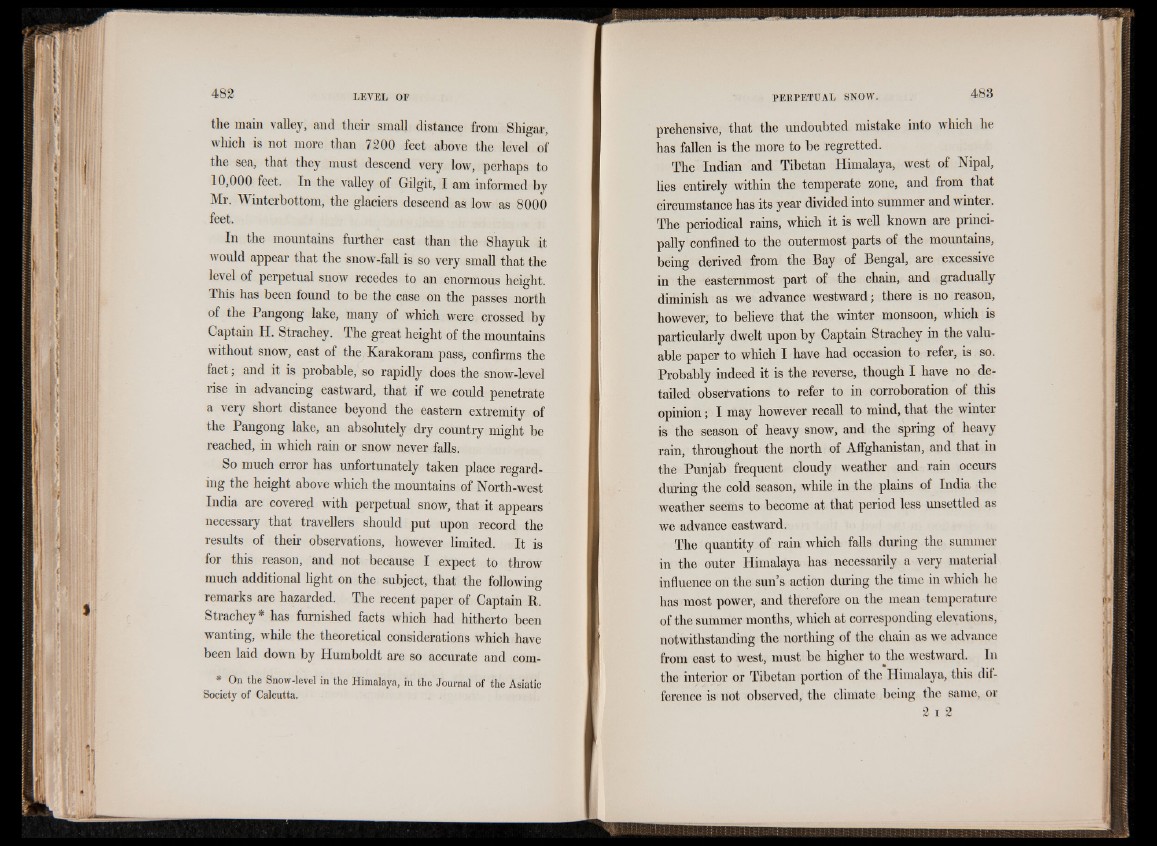
the main valley, and their small distance from Shigar,
which is not more than 7200 feet above the level of
the sea, that they must descend very low, perhaps to
10,000 feet. In the valley of Gilgit, I am informed by
Mr. Winterbottom, the glaciers descend as low as 8000
feet.
In the mountains further east than the Shayuk it
would appear that the snow-fall is so very small that the
level of perpetual snow recedes to an enormous height.
This has been found to be the case on the passes north
of the Pangong lake, many of which were crossed by
Captain H. Strachey. The great height of the mountains
without snow, east of the Karakoram pass, confirms the
fact; and it is probable, so rapidly does the snow-level
rise in advancing eastward, that if we could penetrate
a very short distance beyond the eastern extremity of
the Pangong lake, an absolutely dry country might be
reached, in which rain or snow never falls.
So much error has unfortunately taken place regarding
the height above which the mountains of North-west
India are covered with perpetual snow, that it appears
necessary that travellers should put upon record the
results of their observations, however limited. It is
for this reason, and not because I expect to throw
much additional fight on the subject, that the following
remarks are hazarded. The recent paper of Captain R.
Strachey* has furnished facts which had hitherto been
wanting, while the theoretical considerations which have
been laid down by Humboldt are so accurate and com-
* On the Snow-level in the Himalaya, in the Journal of the Asiatic
Society of Calcutta.
prehensive, that the undoubted mistake into which he
has fallen is the more to be regretted.
The Indian and Tibetan Himalaya, west of Nipal,
lies entirely within the temperate zone, and from that
circumstance has its year divided into summer and winter.
The periodical rains, which it is well known are principally
confined to the outermost parts of the mountains,
being derived from the Bay of Bengal, are excessive
in the easternmost part of the chain, and gradually
diminish as we advance westward; there is no reason,
however, to believe that the winter monsoon, which is
particularly dwelt upon by Captain Strachey in the valuable
paper to which I have had occasion to refer, is so.
Probably indeed it is the reverse, though I have no detailed
obseivations to refer to in corroboration of this
opinion; I may however recall to mind, that the winter
is the season of heavy snow, and the spring of heavy
rain, throughout the north of Affghanistan, and that in
the Punjab frequent cloudy weather and rain occurs
during the cold season, while in the plains of India the
weather seems to become at that period less unsettled as
we advance eastward.
The quantity of rain which falls during the summer
in the outer Himalaya has necessarily a very material
influence on the sun’s action during the time in which he
has most power, and therefore on the mean temperature
of the summer months, which at corresponding elevations,
notwithstanding the northing of the chain as we advance
from east to west, must be higher to^the westward. In
the interior or Tibetan portion of the Himalaya, this difference
is not observed, the climate being the same, or
2 i 2